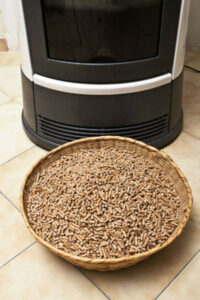In the cold, snowy winters of Maryland, keeping your home properly heated is a major concern. Along with the demand for effective home heating comes a wide variety of options. Heating units can run on many different fuels such as wood, natural gas, heating oil, or electricity, each with varying costs and eco-friendly characteristics. They can produce different types of heat, from fire to embers or radiating heat coils. All of these options can overwhelm any homeowner, so it helps to break down the advantages and disadvantages of each method of heating.
In recent years, pellet stoves have gained more popularity. These stoves burn wood pellets to heat the home. The pellets are specially processed for pellet stoves by debarking the wood, grinding it, drying it and compressed the product into small pellets. Some pellets utilize other bio-fuels, but wood pellets are the most common. An advantage of wood pellets is that they are more economical than electricity, heating oil and propane.
Regarding the environmental costs of burning wood pellets, they burn very efficiently, giving off virtually no harmful emissions. In addition, wood pellets are a renewable resource, so there is little risk of eventually running out like there is with heating oil or natural gas. Wood pellet stoves can also run for up to 16 hours without needing to be refilled, which serves as a convenient feature for working households where the stove can be tended very often.
Storage is another convenience offered by wood pellet stoves. The pellets are much more condensed than traditional pieces of wood. A traditional cord of wood takes up 128 cubic feet, while one ton of wood pellets only requires 80 cubic feet. Both these volumes create the same amount of heat, but wood pellets only need two-thirds the space of wood. In urban communities, where traditional wood is hard to come by and very expensive, wood pellets can act as an affordable, effective heating option.
On the other hand, wood pellet stoves do have some disadvantages. For one, wood pellet stoves require electricity to feed the pellets into the chamber and to power the fan that distributes the hot air to the house. In the case of a power outage, the wood pellet stove could not function. Battery back-up systems can be installed, but they will only last up to eight hours.
Because pellets require more processing, they also cost more than natural firewood in most areas. One cord of wood costs between $125 and $200, while one ton of wood pellets costs $200 to $250, and both volumes produce the same amount of heat. When determining the overall cost of operating a wood pellet stove, consider the cost of the pellets and their availability in your area and the cost of electricity needed to run the stove.
Finally, wood pellets are sold in 40 pound bags, which may pose challenges for some homeowners. To decide if a pellet stove would be a wise investment for heating your home, fully consider how the advantages and disadvantages fit into your specific situation. Instead of contacting a mass merchandiser with pellet stove questions, get in touch with a stove specialist. If you live in the Elkton, Maryland area, contact Ace Chimney Sweeps for a professional consultation. These experts will ensure you make the best choice on the ideal heating unit for your home.

